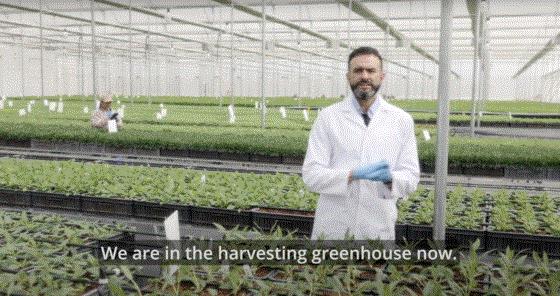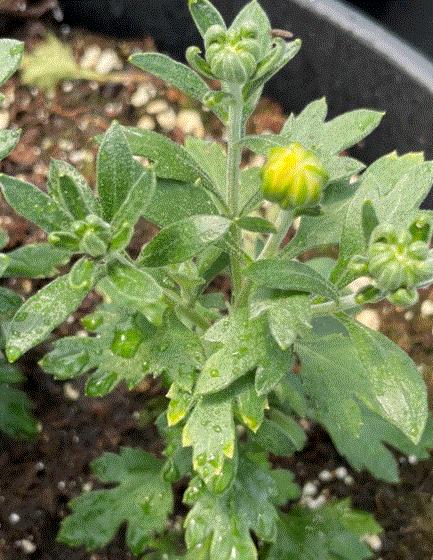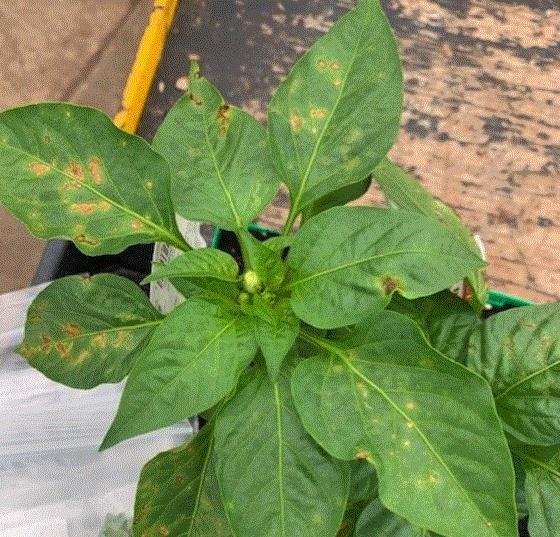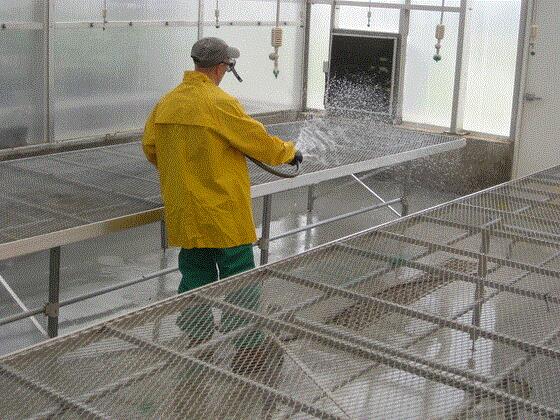How It’s Made: Perennials
Earlier this week, I binge-watched an excellent three-part video series from Darwin Perennials. I wanted to share it with you because it’s so well-produced—and quite fascinating! Understanding what goes into growing, shipping and delivering high-quality—and perishable—products produced thousands of miles from your wholesale greenhouse is a truly amazing feat. I used to love the TV show “How it’s Made,” and I always thought it would be cool for our industry to get featured. This Darwin series fit right into my nerdy nature.

In THE LIFE OF A PERENNIAL CUTTING, three short videos (Clean Stock Program, Propagation & Harvesting and Cold Chain) explain what it takes to deliver millions of perennial cuttings from Darwin's 15-hectare farm outside of Bogota, Colombia, to growers in six different countries. The best part is that you hear it from the folks running the farm, and their pride shines through the entire series.
In just over 15 total minutes (about the length of a “How it’s Made” episode) the three videos take you behind the scenes into Darwin’s tissue culture lab, hardening greenhouses, nucleus blocks, propagation greenhouses, packing rooms and shipping warehouses. Once you’ve seen the care that goes into the process from beginning to end, I guarantee you’ll have a greater appreciation when fresh young perennial plants arrive at your dock.
Call me crazy, but I think these videos are perfect to share with friends and family who might be interested in how plants come to market or where the plants you grow start their journey.

Nick’s Tip of the Week: Late-Season Mum Rescue
Each week, I’ll work with my buddy Nick Flax, a technical services expert at Ball, to share a concern that’s come up during one of his numerous calls with growers across North America. This week, he’s sharing a timely tip to help you prepare for an issue that might soon arise in your garden mum crop.
PROBLEM: As is the case every year, summer weather across most of North America is unpredictable and highly variable, and 2024 has been no different. As a result, it’s not surprising that my phone and email tend to be quite active in August and September when many of you encounter challenges keeping your crops happy and on track.

NICK’S TIP: If (when …) weather impacts your garden mum crop, it’s easy to feel like you’ve run out of options. However, there’s almost always something you can do to combat adverse growing conditions. However, turning your crop around effectively comes down to quick and decisive action.
This week, let’s look at some strategies to combat late crown budding that can result from variable weather and environmental conditions.
Air temperature in the mid to low 60s F often leads to crown budding. Physiological stress from low mineral nutrition, which often occurs during downpours and when extreme temperatures shut down nutrient uptake, also contributes to incidences of crown budding. While I’ve written about crown bud management strategies before (check out my past tips or our TECH ON DEMAND DOCUMENTS on the Ball Seed Garden Mums webpage), some growers have encountered two or even three flushes of crown buds this season. This has put quite a few of you into panic mode, so here are a few things to keep in mind if this has happened in your mums this summer:
Any time crown buds occur, your first objective should be to push dormant shoots out from below the buds to cover them up.
The easiest thing to do when you see signs of crown budding—both early and late in the production cycle—is hit the gas with an ammonia-based fertilizer. Apply 20-10-20 or even 20-20-20 (a few times) at 300+ ppm N and keep the pressure on until you see axillary shoots from below the buds push out.
Between planting in June and around early- to mid-July, you can apply ethephon (Florel/Collate) to keep plants vegetative or help encourage lateral shoot breaks to push out. After mid-July, however, the risk of delaying flowering increases significantly. Ethephon is also not a PGR that I suggest inexperienced growers use, and even under the best conditions, some varieties are very sensitive to it (it can slow growth or delay flowering significantly). As such, this is generally not my go-to suggestion.
At this point (week 33), if you’ve recently encountered crown buds (or again for the second or third time), it may not be easy to finish with a stellar crop. But don’t lose hope! Late or repeat crown budding will likely mean your mums will finish a bit on the smaller side, but they are still salvageable. Do the following to give yourself the best shot possible at having a salable crop with strong flower power and a nice mounding habit at finish:
-
Don’t bother disbudding and absolutely DO NOT pinch the crop. This is just a drain on your labor, and it will only slow the crop’s recovery, which you can’t risk now.
-
Push to get one more flush of growth before you’re solidly into natural short days. Increase feed again using an ammonia-based fertilizer like 20-10-20 for a few weeks and hold off on switching to a Cal-Mag, like we normally suggest after short days begin.
-
Get ahold of a GA-based PGR (Fascination or Fresco) and prepare to apply it once or twice. This will help get a little additional stretch on that final flush of vegetative growth and ensure that crown buds are well covered-up. Check out our “GA for Garden Mums” guide on the Ball Mums web page for more details.
-
Once plants have sized up a bit more and true buds are set, begin toning the crop. Keep plants green with a Cal-Mag fertilizer once buds are initiated, but start to leach with clear water once visible buds are set.
-
If you need to correct any general yellowing at this point, avoid adding nitrogen. The old Epsom salts plus iron chelate drench trick works well, or you can apply a “holding feed” like a 0-7-5 with micronutrients to help get some green-up.
-
When plants have reached an acceptable size, tone them further with a light paclobutrazol drench. A 1 ppm drench should be enough to help toughen-up these relatively soft mums that you just pushed hard pretty much all the way to the finish line.
Every year, the Tech On Demand team and Ball Mums experts help growers through this process, and while it’s certainly a nail-biter, it can be done successfully if you act quickly. Keep in mind, these rescue protocols can increase your input costs, so be sure the economics make sense before you implement them.

Mum Case Study: Low pH & Corrective Action
Here’s a real-world situation a grower was dealing with a year ago and they reached out to the Tech On Demand team for answers. I saved the interaction to share again this season … and now’s the time:
Tip necrosis was observed Week 33, as you see in the photos. A PourThru pH test revealed values were between 4.7 and 5.0, indicating these plants were likely exhibiting iron (Fe) and manganese (Mn) toxicity. (Note: Both of these elements become more available to plants at low pH and accumulate in the tips of new leaves.)

Fig. 1C shows that the crop grew past damaged leaves by week 38. Examining within the canopy, damaged leaves were located about 4 to 5 nodes below the buds (Fig. 1D).
Our team worked with this mum grower to implement three corrective measures in order to save the crop:
-
Pots were drenched with flowable lime at 2 qt. per 100 gallons of water immediately (in week 33) and again the following week at a rate of 2 qt. per 100 gallons in an effort to bring pH values between 5.5 and 6.0—avoiding Fe and Mn toxicity.
-
Fertilizer was switched from an acidic 20-10-20 to a basic 14-4-14 for one week and then continued on an alternating schedule between 14-4-14 and 20-10-20 to curb pH drop. (Ammoniacal nitrogen from 20-10-20 was needed to encourage growth past damaged leaves.)
-
Because plant roots were in poor condition, irrigation was strictly managed to ensure the substrate was drying down between waterings to encourage root development throughout the container.
Here are some key tips to avoid the issue in the future:
-
Track pH and EC throughout production using 1:2, SME or PourThru method.
-
Check roots to make sure irrigation is managed correctly—encouraging healthy, white roots.
-
Maintain a pesticide program following labels and FRAC code rotations.
-
Take diagnostic steps and corrective measures immediately when nutrient or disease symptoms are observed.

Leaf Spots on Peppers
Fall crop production leads to many calls, emails and texts to the Tech On Demand team. Last year, a grower reached out with leaf spots on peppers. The crop was looking good, clean and green and then all of a sudden, “it just exploded into leaf spots.”

When the tech experts looked at the photo, they agreed it certainly appeared to be Xanthomonas. Thankfully, they could pass along THIS ALERT from our friends at e-GRO.
According to the alert, minimizing wetness is a good way to avoid this disease—especially at night—so try to water early in the day and not just before dusk. Another strategy to minimize risk and spread of Xanthomonas is to avoid handling plants when they’re still wet. And … you can probably guess this one ... greenhouse sanitation between crops is critical. Bacteria can survive for a long time, so as they say, “start clean and stay clean.”
Sanitation Between Seasons
Speaking of … How many times have I mentioned sanitation over the 150-plus weeks this newsletter has hit your inbox? Let’s just say a lot. But as you wrap up fall crops (and soon enough, poinsettias) it’s going to be a good time to deep clean your structures, surfaces, and anywhere else you can get to.

This FACT SHEET from University of Massachusetts is very thorough and covers just about everything you and your team need to remember when sanitizing. From benches and worktables to structures and even containers and your own hands, cleanliness is the best way to avoid disease spread and protect crops from all sorts of issues. I’d suggest bookmarking this fact sheet, sharing it with your entire team and covering it in a group meeting. The importance of sanitation cannot be overstated, and as often as I reference the topic, you should probably cover it even more often.
Here's a list of steps to prevent disease contamination from UMass:
-
Disinfect benches (which are preferably topped with wire, not wood). Wood benches can be a source for root rot diseases and insect infestations. Algae growing on wood surfaces create an ideal environment for fungus gnats and shore flies. Plant pathogens such as Pythium can grow within the wood and plants rooting into the wood can become infected.
-
Pots, flats and trays should be new or disinfected.
-
Disinfect potting tables—which are preferably made of a non-porous surface such as laminate.
-
Set up washing stations for hand washing and foot baths at the entrances of each greenhouse, especially propagation houses.
-
Keeping hands and fingernails clean can help reduce the spread of diseases. If wearing latex or other protective gloves, clean them as you would your hands, and change periodically. Change the disinfectant in foot baths daily, and wash floor mats weekly.
-
Provide supports throughout the greenhouse to hang hose nozzles. Keep all containers and hose nozzles off the floor to prevent contamination with pathogens.
-
Keep growing media in a clean area and covered.
-
Avoid carrying over plant material.
-
Avoid accumulating dirty pots, old growing media or plant debris in the media mixing area.
-
Make sure trash bins in the greenhouses are covered so that disease spores do not spread to the crop.
-
Use horticultural oil on vegetation/weeds outside, around the greenhouse perimeter, to smother over-wintering pests.

Danziger’s 2025 Tech Sheets
More than 90 new TECHNICAL PRODUCT PAGES for annuals and perennials from Danziger just came across my desk. Well … not literally, because they’re all online. But that’s a lot of new products and a lot of new info for those of you growing Danziger plants to offer next spring.

Here’s what you can expect, in terms of culture info, from the experts at Danziger:
-
Indepth technical specifications
-
Propagation tips
-
Finishing tips
-
Trials pictures
For a quick refresher on some of the new products available from Danziger for 2025, CHECK OUT OUR VIDEO FROM CALIFORNIA SPRING TRIALS. We cover dozens of new varieties—and with almost 1,000 views, this video must be a good one!
Finish Line ...
Twice a week, the entire Ball Publishing team gathers in-person and virtually to update each other on activities and talk through anything that needs group input. These are short meetings and (almost) always productive. In addition, every other month or so, all the editors and some additional knowledgeable industry folks gather for half a day to talk about high-level industry trends and what we’ve heard during travels, calls and chats with folks around the industry.
Lately, top-of-mind topics include costs associated with labor and shipping, staying relevant with all the shoppers who were attracted to gardening during the pandemic, industry news and views we picked up at the summer events, and new trends in automation technology, biosolutions and crop culture. I imagine none of these topics come as a surprise to you.
You can expect articles, webinars and other content addressing these big-picture issues in the pages of GROWERTALKS, GREEN PROFIT and INSIDE GROWER in the coming months.
But I’m really interested in what topics are on YOUR mind. What’s keeping you up at night? What have you and your team been discussing lately?
Shoot me an EMAIL or find me on social media to share anything you want. Our next editorial meeting is in a few weeks, and I’ll get any and all ideas on the agenda.
Until next week … Keep an eye on those mums!



Please feel free to send your comments, constructive criticism and topic ideas to me at bcalkins@ballhort.com.

Bill Calkins
Editor - Tech On Demand
This email was received by you and 25,783 other fine subscribers!
If you're interested in advertising in Tech On Demand, contact Kim Brown ASAP and she'll hook you up.